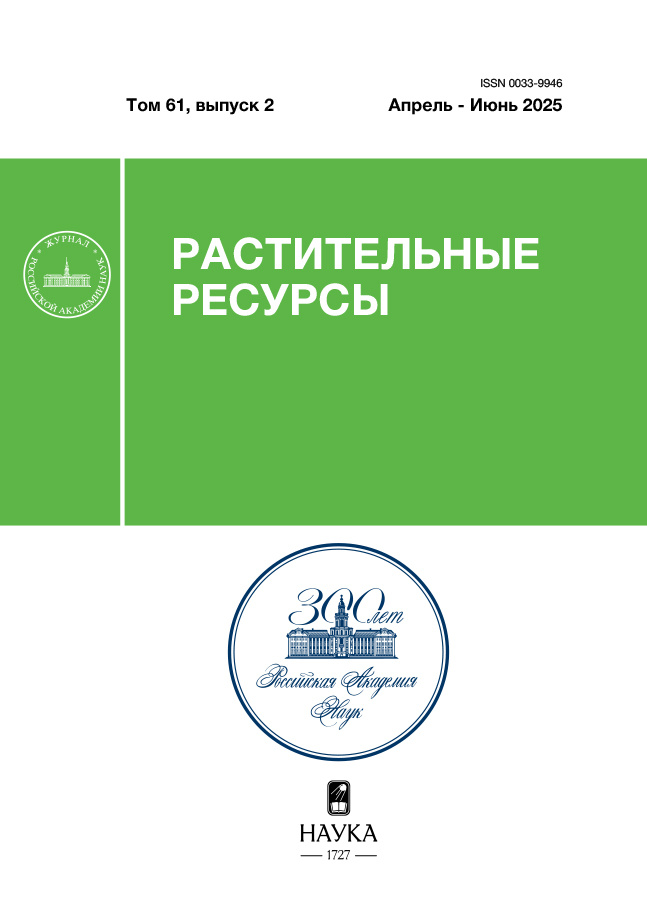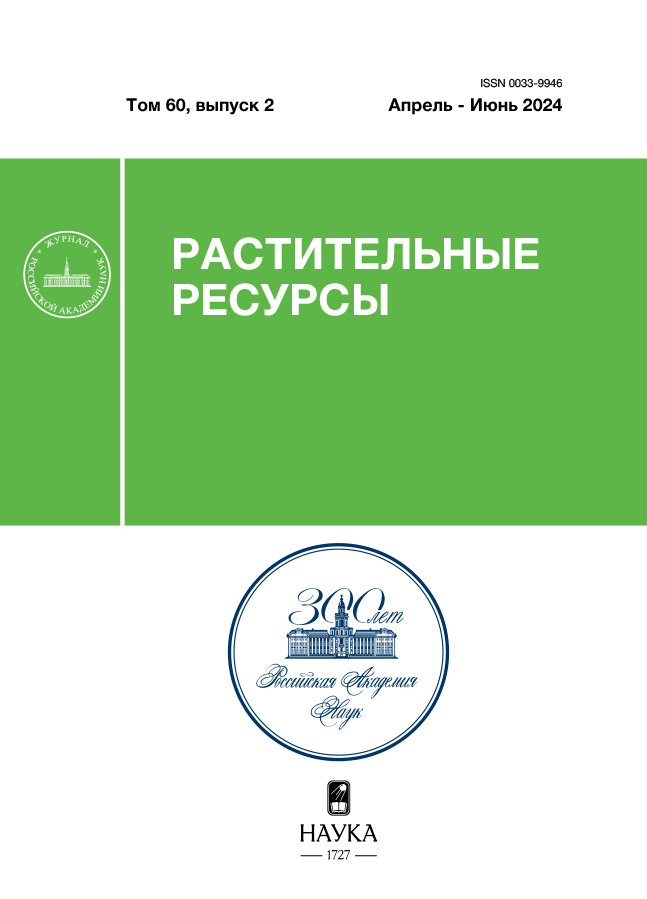Biology of Ornithogalum fischerianum (Hyacinthaceae) in the Orenburg Region
- Authors: Mustafina A.N.1, Abramova L.M.1
-
Affiliations:
- South-Ural Botanical Garden-Institute of Ufa Federal Scientific Centre of the Russian Academy of Sciences
- Issue: Vol 60, No 2 (2024)
- Pages: 75-88
- Section: Articles
- URL: https://medjrf.com/0033-9946/article/view/674413
- DOI: https://doi.org/10.31857/S0033994624020055
- EDN: https://elibrary.ru/PYHVBQ
- ID: 674413
Cite item
Abstract
The morphometric variability and vital state of the understudied ornamental species Ornithogalum fischerianum Krasch. (Hyacinthaceae) in 10 natural coenopopulations (CP) of the Orenburg Region were studied. It was found that the species prefers dry alkaline steppes, and is occasionally found in sandy habitats and fallows. The variability of all studied traits is within the species’ reaction norms (Cv = 5.7—32.8%). For most morphometric parameters, the highest values were determined in the Rassypnoye CP, and the lowes — in the Dmitrovsky and Zemlyansky CPs. The results of the discriminant analysis show the noticeable morphometric structural diversity of individuals in most CPs. The highest phenotypic diversity is observed in the Goryun CP, and the lowest in the Rassypnoye CP. The vitality type of most coenopopulations is prosperous, one cоenopopulation is classified as depressive. It was found that the species does well in disturbed steppes, where there is no or reduced competition with large turf grasses, but soil compaction, on the contrary, negatively affects its growth and development. Despite the fair stability of most O. fischerianum coenopopulations, many of them are small, so further monitoring of the species’ habitats is necessary.
Full Text
About the authors
A. N. Mustafina
South-Ural Botanical Garden-Institute of Ufa Federal Scientific Centre of the Russian Academy of Sciences
Author for correspondence.
Email: alfverta@mail.ru
Russian Federation, Ufa
L. M. Abramova
South-Ural Botanical Garden-Institute of Ufa Federal Scientific Centre of the Russian Academy of Sciences
Email: alfverta@mail.ru
Russian Federation, Ufa
References
- Abramova L. M., Shirokikh P. S., Golovanov Ya. M., Kryukova A. V., Mustafina A. N. 2019. On the ecology of rare steppe irises in the South Urals. — Tomsk State University Journal of Biology. 48: 56—72. https://doi.org/10.17223/19988591/48/3 (In Russian)
- Karimova O. A., Abramova L. M., Mustafina A. N., Golovanov Ya. M. 2018. State of coenopopulations of Anthemis trotzkiana (Asteraceae) in Orenburg Region. — Bot. zhurnal. 103(6): 740—754. https://doi.org/10.1134/S0006813618060042 (In Russian)
- Karimova O. A., Abramova L. M., Golovanov Ya. M. 2017. Analysis of the current status of populations of rare plant species of mature monument Troicky Chalk Mountains (Orenburg Region). — Arid Ecosyst. 7(1): 41—48. https://doi.org/10.1134/S2079096117010073 (In Russian)
- Mustafina A. N., Abramova L. M., Karimova O. A. 2023. Ontogenesis and structure of population of Rindera tetraspis Pall. (Boraginaceae) in Orenburg Region. — Arid Ecosyst. 13(4): 412—418. https://doi.org/10.1134/S2079096123040091
- Maevsky P. F. 2014. [Flora of the central part of European Russia]. 11th ed. Moscow. 635 p. (In Russian)
- Agapova N. D. 1977. [Genus Ornithogalum L. Ornamental herbaceous plants for open ground of the USSR]. Leningrad. P. 176—184. (In Russian)
- Agapova N. D. 1979. [The genus Ornithogalum L.] — In: [Flora of the European part of the USSR. Vol. 4]. Leningrad. P. 243—250. (In Russian)
- Ochirova K. S., Dordzhieva V. I., Lidzhieva A. N. 2020. [Anatomical structure of the leaves of Ornithogalum fischerianum growing in Kalmykia]. — In: [Collection of scientific papers of students]. Elista. P. 19—22.
- Pigliucci M., Politi M. G., Bellincampi D. 1991. Implications of phenotypic plasticity for numerical taxonomy of Ornithogalum montanum (Liliaceae). — Can. J. Bot. 69(1): 34—38. https://doi.org/10.1139/b91—006
- Kariuki W., Kako S. 1999. Growth and flowering of Ornithogalum saundersiae Baker. — Sci. Hortic. (Amsterdam). 81(1): 57—70. https://doi.org/10.1016/S0304-4238(98)00233-7
- Kwiatkowska M., Popłońska K., Kaźmierczak A., Stępiński D., Rogala K., Polewczyk K. 2007. Role of DNA endoreduplication, lipotubuloids, and gibberellic acid in epidermal cell growth during fruit development of Ornithogalum umbellatum. — J. Exp. Bot. 58(8): 2023—2031. https://doi.org/10.1093/jxb/erm071
- Tang Y., Li N., Duan J.-A., Tao W. 2013. Structure, bioactivity, and chemical synthesis of OSW-1 and other steroidal glycosides in the genus Ornithogalum. — Chem. Rev. 113(7): 5480—5514. https://doi.org/10.1021/cr300072s
- Yin S., Sun Y.-J., Liu M., Li L.-N., Kong J.-Q. 2016. CDNA isolation and functional characterization of UDP-d-glucuronic acid 4-epimerase family from Ornithogalum caudatum. — Molecules. 21(11): 1505. https://doi.org/10.3390/molecules21111505
- Pavlova M. A. 2010. Formation of introduction populations of some species of Ornithogalum L. genus. — Industrial Botany. 10: 90—95. https://www.elibrary.ru/item.asp?id=37315109 (In Russian)
- Sedelnikova L. L., Kukushkina T. A. 2009. [Seasonal dynamics of the accumulation of the storage compounds in the bulbs of Scilla sibirica and Ornithogalum ponticum]. — Chemistry for Sustainable Development. 17(4): 417—421. https://elibrary.ru/item.asp?id=12834033 (In Russian)
- Pavlova M. A. 2011. Intraspecific variation of morphological characters of Ornithogalum umbellatum L. under conditions of Donetsk Botanical Garden of NAS of Ukraine. — Industrial Botany. 11: 230—235. https://elibrary.ru/item.asp?id=37315191 (In Russian)
- Kosareva L. V., Efremova L. P., Okach M. A. 2020. Decorative characteristics of Ornithogalum species in the climate of the Republic of Mari El. — International Journal of Humanities and Natural Sciences. 1—1(40): 14—17. https://doi.org/10.24411/2500-1000-2020-10003 (In Russian)
- Glubsheva T. N. 2021. Results of introduction tests of Ornithogalum kochii Parl. — Proceedings of Gorsky State Agrarian University. 58(3): 161—165. https://elibrary.ru/item.asp?id=46596812 (In Russian)
- Krasheninnikov I. M. 1935. Ornithogalum fischerianum. — In: Flora of the URSS. Vol. 4. Leningrad. P. 392—393. (In Russian)
- [On the approval of the List of rare and endangered species of plants and animals. Decree of the Government of the Republic of Kazakhstan dated October 31, 2006]. No. 1034. https://adilet.zan.kz/rus/docs/P060001034_
- [Red Book of the Samara Region. 2017. Vol. 1. Rare species of plants and fungi]. Samara. 284 p. (In Russian)
- [Red Book of the Chelyabinsk region: animals, plants, fungi]. 2017. Moscow. 504 p. http://oopt.aari.ru/ref/2226 (In Russian)
- [Red Book of the Voronezh Region. 2011. Vol. 1. Plants. Lichens. Fungi]. Voronezh. 472 p. http://oopt.aari.ru/ref/308 (In Russian)
- Sedelnikova L. L., Kukushkina T. A. 2012. The content of some groups of compositions in the below-ground parts of Crocus, Gladiolus (Iridaceae), Scilla, Muscari, Ornithogalum (Hyacinthaceae). — Rastitelnye Resursy. 48(3): 383—389. https://elibrary.ru/item.asp?id=17823112 (In Russian)
- Sedelnikova L. L., Kukushkina T. A. 2015. The content of some combination groups of the vegetative organs of Ornithogalumum bellatum (Hyacinthaceae). — The Bulletin of KrasGAU. 4: 116—120. https://elibrary.ru/item.asp?id=23676292 (In Russian)
- Mimaki Y., Kuroda M., Sashida Y., Hirano T., Oka K., Dobashi A., Koshino H., Uzawa J. 1996. Three novels rearranged cholestane glycosides from Ornithogalum saundersiae bulbs and their cytostatic activities on leukemia HL-60 and MOLT-4 cells. — Tetrahedron Lett. 37(8): 1245—1248. https://doi.org/10.1016/0040-4039(95)02407-7
- Chen Q.-W., Zhang X., Gong T., Gao W., Yuan S., Zhang P.-C., Kong J.-Q. 2019. Structure and bioactivity of cholestane glycosides from the bulbs of Ornithogalum saundersiae Baker. — Phytochemistry. 164: 206—214. https://doi.org/10.1016/j.phytochem.2019.05.016
- Zlobin Yu. A., Sklyar V. G., Klimenko A. A. 2013. [Populations of rare plant species: theoretical foundations and methods of study]. Sumy. 439 p. (In Russian)
- Zlobin Yu. A. 2012. Rare plant species: floristic, phytocenotic and population approaches. — Biology Bulletin Reviews. 2(3): 226—237. https://doi.org/10.1134/S2079086412030073
- Mirkin B. M., Naumova L. G. 2012. [The current state of the basic concepts of vegetation science]. Ufa. 488 p. (In Russian)
- Golubev V. N. 1962. [The fundamentals of biomorphology of herbaceous plants of the central forest-steppe]. 511 p. (In Russian)
- Ishbirdin A. R., Ishmuratova M. M., Zhirnova T. V. 2005. [Life strategies of the Cephalanthera rubra (L.) Rich. in the Bashkir State Nature Reserve]. — Vestnik of Lobachevsky University of Nizhni Novgorod. Ser. Biology. 1: 85—98. http://www.vestnik.unn.ru/ru/nomera?anum=162 (In Russian)
- Zaitsev G. N. 1990. Mathematics in experimental biology. Moscow. 296 p. (In Russian)
- Khalafyan A. A. 2008. [STATISTICA 6. Statistical analysis of data]. 3rd ed. Moscow. 512 p. (In Russian)
- Kashin A. S., Petrova N. A., Shilova I. V. 2017. Some features of the environmental strategy of Tulipa gesneriana L. (Liliaceae, Liliopsida). — Biology Bulletin. 44(12): 1237—1245. https://doi.org/10.1134/S1062359017100053
Supplementary files















